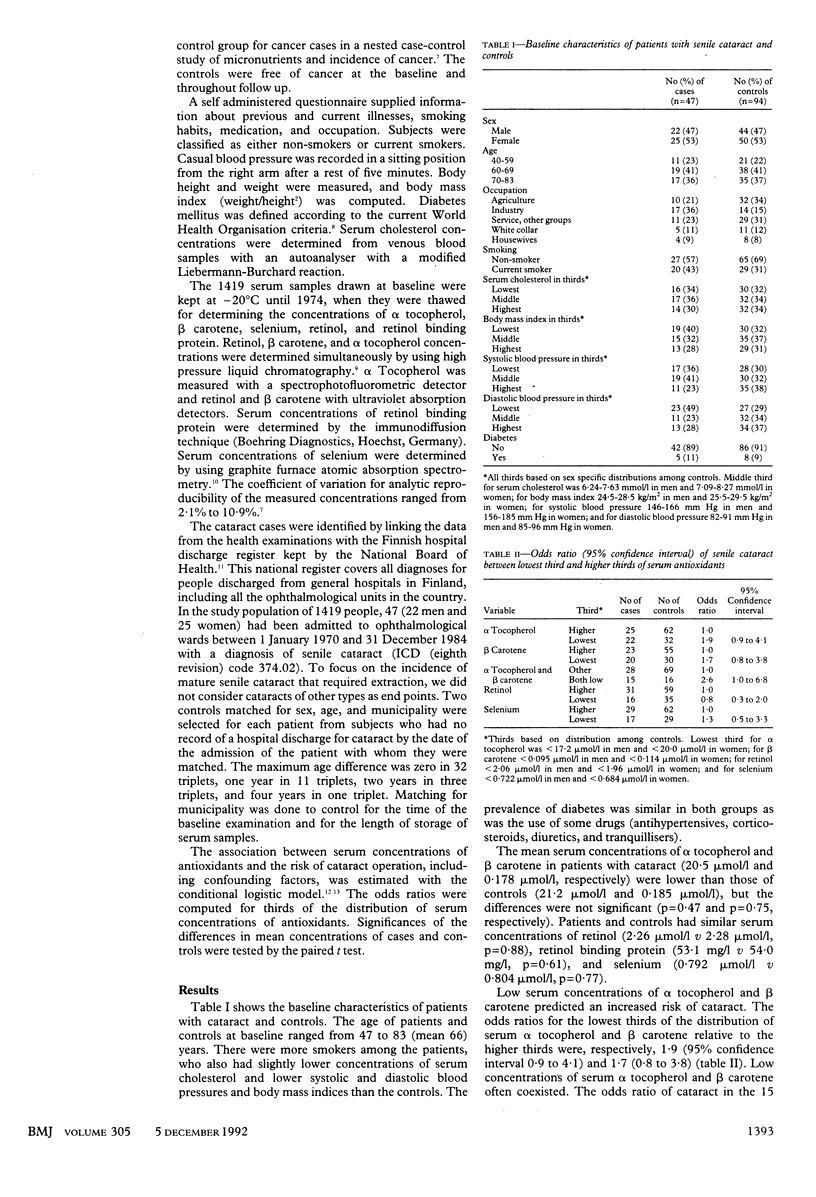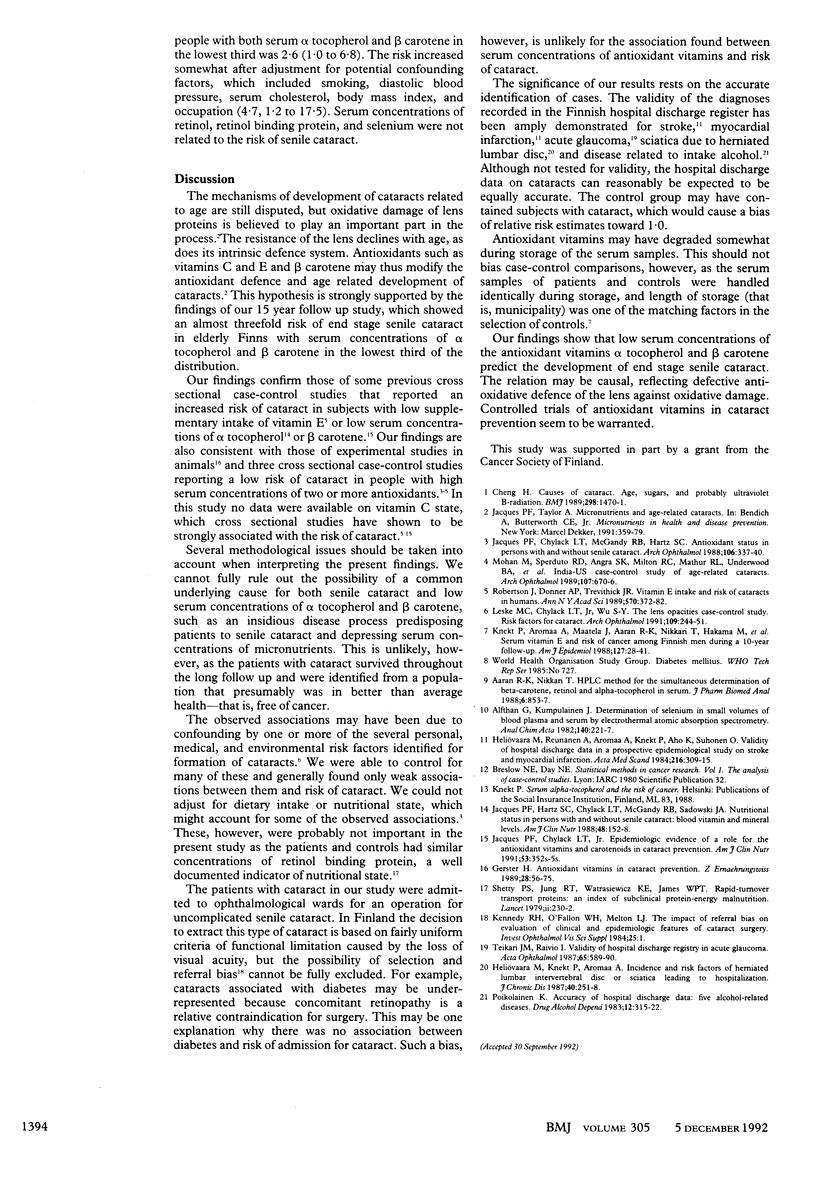Abstract
OBJECTIVE--To investigate serum concentrations of alpha tocopherol, beta carotene, retinol, and selenium for their prediction of end stage cataract. DESIGN--A case-control study, nested within a cohort study, based on the linkage of records of subjects aged 40-83 from a health survey with those from the national Finnish hospital discharge register. SUBJECTS--47 patients admitted to ophthalmological wards for senile cataract over 15 years and two controls per patient individually matched for sex, age, and municipality. MAIN OUTCOME MEASURE--Concentration of serum micronutrients, development of cataract according to whether operation was performed. RESULTS--Low serum concentrations of antioxidant vitamins predicted the development of senile cataract, the odds ratio between the lowest third and the two higher thirds of the distribution of serum concentrations of alpha tocopherol and beta carotene being 1.9 (95% confidence interval 0.9 to 4.1) and 1.7 (0.8 to 3.8), respectively. Patients with both alpha tocopherol and beta carotene concentrations in the lowest third had an odds ratio of 2.6 (1.0 to 6.8) of cataract compared with subjects in the top two thirds. The associations were strengthened by adjustment for potential confounding factors such as occupation, smoking, blood pressure, serum cholesterol concentration, body mass index, and diabetes. No association was found between the serum concentrations of selenium, retinol, and retinol binding protein and the risk of cataract. CONCLUSIONS--Low serum concentrations of the antioxidant vitamins alpha tocopherol and beta carotene are risk factors for end stage senile cataract. Controlled trials of the role of antioxidant vitamins in cataract prevention are therefore warranted.
Full text
PDF


Selected References
These references are in PubMed. This may not be the complete list of references from this article.
- Aaran R. K., Nikkari T. HPLC method for the simultaneous determination of beta-carotene, retinol and alpha-tocopherol in serum. J Pharm Biomed Anal. 1988;6(6-8):853–857. doi: 10.1016/0731-7085(88)80101-8. [DOI] [PubMed] [Google Scholar]
- Cheng H. Causes of cataract. BMJ. 1989 Jun 3;298(6686):1470–1471. doi: 10.1136/bmj.298.6686.1470. [DOI] [PMC free article] [PubMed] [Google Scholar]
- Heliövaara M., Knekt P., Aromaa A. Incidence and risk factors of herniated lumbar intervertebral disc or sciatica leading to hospitalization. J Chronic Dis. 1987;40(3):251–258. doi: 10.1016/0021-9681(87)90161-5. [DOI] [PubMed] [Google Scholar]
- Heliövaara M., Reunanen A., Aromaa A., Knekt P., Aho K., Suhonen O. Validity of hospital discharge data in a prospective epidemiological study on stroke and myocardial infarction. Acta Med Scand. 1984;216(3):309–315. doi: 10.1111/j.0954-6820.1984.tb03809.x. [DOI] [PubMed] [Google Scholar]
- Jacques P. F., Chylack L. T., Jr Epidemiologic evidence of a role for the antioxidant vitamins and carotenoids in cataract prevention. Am J Clin Nutr. 1991 Jan;53(1 Suppl):352S–355S. doi: 10.1093/ajcn/53.1.352S. [DOI] [PubMed] [Google Scholar]
- Jacques P. F., Chylack L. T., Jr, McGandy R. B., Hartz S. C. Antioxidant status in persons with and without senile cataract. Arch Ophthalmol. 1988 Mar;106(3):337–340. doi: 10.1001/archopht.1988.01060130363022. [DOI] [PubMed] [Google Scholar]
- Jacques P. F., Hartz S. C., Chylack L. T., Jr, McGandy R. B., Sadowski J. A. Nutritional status in persons with and without senile cataract: blood vitamin and mineral levels. Am J Clin Nutr. 1988 Jul;48(1):152–158. doi: 10.1093/ajcn/48.1.152. [DOI] [PubMed] [Google Scholar]
- Knekt P., Aromaa A., Maatela J., Aaran R. K., Nikkari T., Hakama M., Hakulinen T., Peto R., Saxén E., Teppo L. Serum vitamin E and risk of cancer among Finnish men during a 10-year follow-up. Am J Epidemiol. 1988 Jan;127(1):28–41. doi: 10.1093/oxfordjournals.aje.a114788. [DOI] [PubMed] [Google Scholar]
- Leske M. C., Chylack L. T., Jr, Wu S. Y. The Lens Opacities Case-Control Study. Risk factors for cataract. Arch Ophthalmol. 1991 Feb;109(2):244–251. doi: 10.1001/archopht.1991.01080020090051. [DOI] [PubMed] [Google Scholar]
- Mohan M., Sperduto R. D., Angra S. K., Milton R. C., Mathur R. L., Underwood B. A., Jaffery N., Pandya C. B., Chhabra V. K., Vajpayee R. B. India-US case-control study of age-related cataracts. India-US Case-Control Study Group. Arch Ophthalmol. 1989 May;107(5):670–676. doi: 10.1001/archopht.1989.01070010688028. [DOI] [PubMed] [Google Scholar]
- Poikolainen K. Accuracy of hospital discharge data: five alcohol-related diseases. Drug Alcohol Depend. 1983 Dec;12(4):315–322. doi: 10.1016/0376-8716(83)90002-9. [DOI] [PubMed] [Google Scholar]
- Robertson J. M., Donner A. P., Trevithick J. R. Vitamin E intake and risk of cataracts in humans. Ann N Y Acad Sci. 1989;570:372–382. doi: 10.1111/j.1749-6632.1989.tb14936.x. [DOI] [PubMed] [Google Scholar]
- Shetty P. S., Watrasiewicz K. E., Jung R. T., James W. P. Rapid-turnover transport proteins: an index of subclinical protein-energy malnutrition. Lancet. 1979 Aug 4;2(8136):230–232. doi: 10.1016/s0140-6736(79)90241-1. [DOI] [PubMed] [Google Scholar]
- Teikari J. M., Raivio I. Validity of hospital discharge registry in acute glaucoma. Acta Ophthalmol (Copenh) 1987 Oct;65(5):589–590. doi: 10.1111/j.1755-3768.1987.tb07046.x. [DOI] [PubMed] [Google Scholar]


